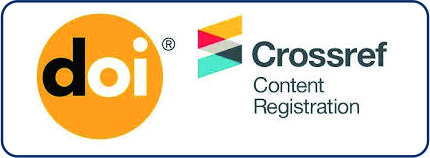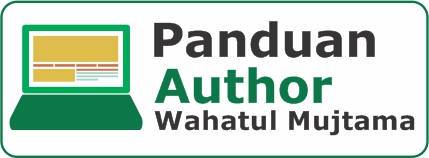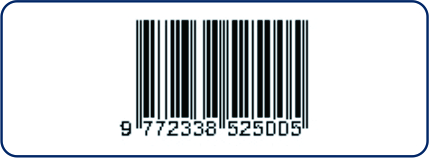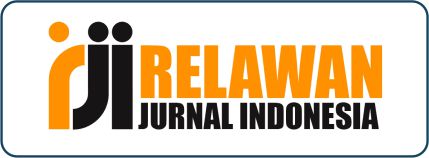Submissions
Author Guidelines
AUTHOR GUIDELINES
General Author Guidelines
1. The article must be scientific (which is substantially contained corpus, perspective, and context), either based on the empirical research or conceptual ideas. The content of the article has not published yet in any Journal, and should not be submitted simultaneously to another Journal.
2. Articles submitted for publication must meet the following conditions:
The article is typed in 1 spacing and the article must be in the range between 15-25 pages, not including title, abstract, keywords, and bibliography, on A4-paper size, with font of "Calibri" 11 pt. (See the journal template).
Writing organizations include: 1) title, 2) author's name (without title), 3) author's agency or affiliation (s), 4) email of author(s), (5) abstract in English and Bahasa Indonesia no more than 250 words, 6) keywords, 7) introduction, 8) discussion, 9) conclusion, and (10) bibliography. The title should not be more than 15 words. Author’s name(s) should be written in the full name without academic title (degree), and completed with institutional affiliation(s) as well as corresponding address (e-mail address). Abstract consisting of the discourses of the discipline area; the aims of the article; methodology (if any); research finding; and contribution to the discipline of areas study. The abstract should be written in English and Bahasa Indonesia. Introduction consisting of the literature review (would be better if the research finding is not latest than ten years) and novelty of the article; scope and limitation of the problem discussed; and the main argumentation of the article. Discussion or description and analysis consisting of the reasoning process of the article’s main argumentation. The conclusion should be consisting of answering research problem, based on the theoretical significance/conceptual construction. All of the bibliography used should be written properly based on APA syles, following the example as follows:
Book:
Mahmood, T. (1987). Family Law in Islamic Contries; History, Text and Comparative Analisys. New Delhi: Academy of Law and Religion.
Journal :
Ali, M. M. (2001). The Concept of Modernization: An Analysis of Contemporary Islamic Thought. American Journal of Islamic Social Sciences, Vol. 14, No.1 (Spring 2001): p.13-26.
It is suggested the use of a reference manager, MENDELEY and ZOTERO. The order of the bibliography is written alphabetically. Transliteration Arab-Latin follow the guidelines of transliteration.
When a source is cited for the first time, full information is provided: full name(s) of author(s), title of the source in italic, place of publication, publishing company, date of publication, and the precise page that is cited. For the following citations of the same source, list the author’s last name, two or three words of the title, and the specific page number(s). The word ibid., op.cit., and loc.cit. are may not be used any more.
Example in footnotes:
1Mircea Eliade (ed.), The Encyclopedia of Religion, vol. 8 (New York: Simon and Schuster, 1995), h. 18.
2Norman Daniel, Islam and the West (Oxford: One World Publications, l99l), h. 190.
3Mircea Eliade (ed.), The Encyclopedia, h. 119-30.
Detail informations of the footnotes:
- Holy book
Al-Qur’ân, Al-Baqarah/2: 185.
Perjanjian Baru, Mrk. 2: 18.
- Qur’anic translation
1Departemen Agama RI, al-Qur’an dan Terjemahannya (Jakarta: Darus Sunnah, 2005), h. 55.
- Book
1Muḥammad ‘Ajjaj al-Khaṭib, Uṣul al-Ḥadith: ‘Ulumuh wa Muṣṭalaḥuh (Beirut: Dâr al-Fikr, 1989), h. 57.
- Buku terjemahan
1Toshihiko Izutsu, Relasi Tuhan dan Manusia: Pendekatan Semantik terhadap al-Qur’an, terj. Agus Fahri Husein dkk (Yogyakarta: Tiara Wacana, 2003), h. 14.
- Voluminous book
1Muḥammad al-Ṭâhir b. ‘Ashur, al-Taḥrir wa al-Tanwir, Vol. 25 (Tunisia: Dâr al-Suḥûn, 2009), h. 76.
1Muḥammad b. Ismâ‘il al-Bukharî, al-Jami‘ al-Ṣaḥiḥ, Vol. 2 (Beirut: Dar al-Kutub al-‘Ilmiyah, 1999), h. 77.
- Article in book
1Sahiron Syamsuddin, “Metode Intratekstualitas Muhammad Shahrur dalam Penafsiran al-Qur’an” dalam Abdul Mustaqim dan Sahiron Syamsuddin (eds.), Studi al-Qur’an Kontemporer: Wacana Baru Berbagai Metodologi Tafsir (Yogyakarta: Tiara Wacana, 2002), h. 139.
- Article in encyclopaedia
1M. Th. Houtsma, “Kufr” dalam A. J. Wensinck, at al. (ed.), First Encyclopaedia of Islam, Vol. 6 (Leiden: E.J. Brill, 1987), h. 244.
- Article in journal
1Muhammad Adlin Sila, “The Festivity of Maulid Nabi in Cikoang, South Sulawesi: Between Remembering and Exaggerating the Spirit of Prophet”, Studia Islamika 8, no. 3 (2001): h. 9.
- Article in mass media
1Masdar F. Mas’udi, “Hubungan Agama dan Negara”, Kompas, 7 Agustus 2002.
- Article in Internet
1Muḥammad Shaḥru>r, “Reading the Religious Teks: a New Approach” dalam http://www.shahrour.org/25 Februari 2010/diakses 5 Juni 2010.
- Thesis or dissertation
1Syahruddin Usman, “Kinerja Guru Penddikan Agama Islam pada SMAN dan SMKN Kota Makassar”, Disertasi (Makassar: PPs UIN Alauddin, 2010), h. 200.
The guidelines for Indonesia-Arabic transliteration are as follows:
|
No |
Arab |
Indonesia |
Arab |
Indonesia |
|
1 |
أ |
’ |
ض |
Ḍ |
|
2 |
ب |
B |
ط |
Ṭ |
|
3 |
ت |
T |
ظ |
Ẓ |
|
4 |
ث |
Ṡ |
ع |
‘ |
|
5 |
ج |
J |
غ |
G |
|
6 |
ح |
Ḥ |
ف |
F |
|
7 |
خ |
Kh |
ق |
Q |
|
8 |
د |
D |
ك |
K |
|
9 |
ذ |
Ż |
ل |
L |
|
10 |
ر |
R |
م |
M |
|
11 |
ز |
Z |
ن |
N |
|
12 |
س |
S |
و |
W |
|
13 |
ش |
Sy |
ھ |
H |
|
14 |
ص |
S |
ي |
Y |
To sound a long vowel (madd), author should write a horizontal mark (macron) above the letter a, i, and u. The double vowel sound (diftong) is marked by marging of the vowel (harakat) and letter to be “aw” and “ay”, such like maw‘iẓah, laylah. Shaddah or double sound is transliterated by writing twice of the letter, like kaffah, ṭayyib. Alif-lam (lam ta‘rif) is transliterated as its origins, like al-manhaj and al-salam. The word which contains ta’ marbuṭah has two signs: first, if the word placed as ṣifah (modifier) or muḍaf ilayh, it is transliterated as “ah”, like al-akhlaq al-karimah, yawm al-qiyamah; second, if the function of the word is muḍaf, it should be transliterated as at, like kalimat allah.
3. Every submitted paper is independently reviewed by at least one peer-reviewer. The decision for publication, amendment, or rejection is based upon their reports/recommendation. If single or more reviewers consider a manuscript unsuitable for publication in this journal, a statement explaining the basis for the decision will be sent to the authors within three months of the submission date.
Revision of Manuscripts
Manuscripts sent back to the authors for revision should be returned to the editor without delay. Revised manuscripts can be sent to editorial office through the Online Submission Interface. The revised manuscripts returned later than three months will be considered as new submissions.
Tables and Figures
Tables are sequentially numbered with the table title and number above the table. Tables should be centered in the column or on the page. Tables should be followed by a line space (12 pt). Elements of a table should be single-spaced. However, double spacing can be used to show groupings of data or to separate parts within the table. Table headings should be in 10 pt. Tables are referred in the text by the table number, e.g., Table 1. Do not show the vertical line in the table. There is only horizontal line should be shown in the table. Figures should, preferably, be included in the electronic version of the manuscript in an appropiate format as follows; JPG, PNG.
Manuscript
The manuscript should be typed using word processors (Microsoft Word, Open Office, Rich Text Format, or WordPerfect document file format) software. The font used throughout the paper is Times New Roman. The paper size is A4 (i.e., 210 x297 mm), with a 4 cm margin at the top, 3 cm margin at the bottom, 4 cm margin on the left, and 3 cm margin on the right.
When submitting a manuscript, the author guarantees that the same manuscript or a similar version has not been submitted to any other journal or publication. Submissions must be accompanied by footnotes, and must also be accompanied by a full bibliography of works cited in the text. Spelling, capitalization, and punctuation must be consistent within each article.
Manuscript submitted to this journal should follow the heading below, except for the review article:
Title; Authors Name; Authors Affiliation; The E-mail Address; Abstract; Keywords; Introduction; Discussion; Conclusion; Acknowledgments; and References.
Paper Title
The title should reflect a specific focus of study based on the main issue of the article so that the author can get a general statement and sub-title specifically confining the scope of study. In addition, the title should be precise.
The title should be in 12 pt capital bold of Calibri and be centered. The title should have 0 pts space above and 12 pts below.
Authors Name and Affiliations
Write Author(s) names without a title and professional positions such as Prof, Dr, etc. Do not abbreviate your last/family name. Always give your full name. Write clear affiliation of all Authors.
Abstract and Keywords
An abstract looks like an advertisement of the article. The reader will continue reading all the article if he is interested in its abstract. Thus, the abstract should tell the prospective reader what the writer did and highlight the key findings. Avoid using uncommon abbreviations. The abstract must be accurate, brief, clear, precise, honest and specific. Use words which reflect the precise meaning. Please consider word limitations (150-250 words) with single spacing, one paragraph and font of Calibri 10 pt .
Keywords are the labels of your article and are helpful for the indexing and searching. Therefore the keywords should represent the content and highlight of the article. Use the words which only focus on your article. Each word/phrase in keyword should be separated by a comma (,) and use font of Calibri10pt.
Introduction
In Introduction, authors should state the objectives of the work at the end of introduction section. Before the objective, authors should provide an adequate background, and short literature survey in order to record the existing solutions, to show the differences from previous researches, to show the main limitation of the previous researches, to show what you want to achieve or solve the limitation, to show the novelties of the paper, and to show theoretical construct (if needed) of the research. At the end, if the articles are results of a research, authors should state the methods used.
Discussion
Discussions should explore the meaning of the article. The discussion is the most important part of your article. Here you get a chance to sell your data. Discussions could begin with a brief summary of the scientific findings from previous researcher’s authors should explore things that relate to the objectives of the work and give a scientific interpretation and reasons for each of the results or findings presented.
Conclusions
The conclusion should answer the research objectives clearly. Tells how your work will find a theory of knowledge. Without a clear conclusion, reviewers and readers will find it difficult to assess the benefits of your work. Do not restate the abstract, or just list from analysis.
Acknowledgment
Recognize those who helped in the research, especially funding supporter of your research. Include individuals who have assisted you in your study: Advisors, Financial supporters, or may another supporter, i.e. Proofreaders, Typists, and Suppliers, who may have given materials.
References
This journal charges the following author fees :
Article Submission: 0.00 (IDR)
Authors are required to pay an Article Submission Fee as part of the submission process to contribute to review costs.
Fast-Track Review: 0.00 (IDR)
With the payment of this fee, the review, editorial decision, and author notification on this manuscript is guaranteed to take place within 4 weeks.
Article Publication: 0.00 (IDR)
If this paper is accepted for publication, you will be asked to pay an Article Publication Fee to cover publications costs.
If you do not have funds to pay such fees, you will have an opportunity to waive each fee. We do not want fees to prevent the publication of worthy work
PENULISAN KUTIPAN DAN DAFTAR PUSTAKA JURNAL NUKHBATUL 'ULUM
FORMAT APA (American Psychological Association) STYLE
Penulisan Karya Tulis Dalam Format APA Style
APA (American Psychological Association) style pada umumnya digunakan untuk mensitasi sumber-sumber referensi dalam bidang ilmu sosial. Pedoman sitasi ini menggunakan APA Style edisi revisi ke-6. APA Style memiliki dua bagian utama dalam penulisan sitasi:
- Mengutip dalam teks (In-text citations)
- Daftar pustaka / bibliografi (List of references)
In-Text Citations mengarahkan pembaca untuk menemukan informasi utuh sumber kutipan dalam daftar pustaka yang digunakan penulis.
List of references mengarahkan pembaca untuk menemukan informasi daftar pustaka secara utuh tentang keseluruhan sumber informasi yang dirujuk penulis. List of references berada pada halaman terakhir dari karya tulis.
Pengutipan di dalam Teks (in-text citations)
Pedoman Dasar In Text Citations
- Sumber kutipan dapat ditulis diawal atau akhir kutipan.
- Penempatan sumber kutipan (pada awal atau akhir kutipan) tidak boleh mengaburkan bagian yang dikutip
- Format in text citation menggunakan metode author-date, yaitu nama terakhir pengarang dan tahun terbit sumber yang dikutip muncul dalam teks, contoh (Retnawati, 2014), dan referensi harus muncul lengkap di daftar pustaka pada akhir tulisan.
- Pencantuman halaman sumber kutipan setelah tahun bersifat wajib jika isi teks yang dikutip jelas letak halamannya. Tetapi jika kutipan gagasan / ide dari sumber referensi tidak langsung, tidak perlu menyebutkan nomor halaman dalam pengutipan teks
- Kutipan singkat terdiri dari nama pengarang, tahun penerbitan, dan nomor halaman yang didahului tanda ‘p.’
- Semua sumber referensi yang dikutip dalam teks harus muncul dalam daftar pustaka
- Kata pertama untuk proper noun (nama orang, tempat, dan nama benda secara spesifik), termasuk nama dan inisial pengarang selalu kapital, contoh M. Hatta, D. Jones
- Semua kata dalam judul kapital dan dicetak miring The Closing of the American Mind (Catatan: dalam daftar pustaka hanya kata pertama yang dikapitalkan. The Closing of the American mind
- Semua judul karya jenis buku, dokumentasi, album, film dicetak miring, contoh The Closing of the American Mind
- Semua judul karya artikel diberi tanda kutip “…”,contoh : “Multimedia Narration: Constructing Possible Worlds"; "The One Where Chandler Can't Cry."
- Kutipan panjang lebih dari 40 kata maka tanda kutip tidak diperlukan. Penulisan kutipan dimulai dari baris baru dengan indent ½ inch dari margin kiri yaitu dalam tempat yang sama pada paragraf baru.
- Paraphrase atau ringkasan sebuah ide atau gagasan dari suatu karya tulis lain, hanya diperlukan rujukan nama pengarang dan tahun terbit, namun disarankan oleh APA untuk memberikan nomor halaman.
- Jika penulis lebih dari dua orang, hanya nama belakang penulis pertama yang ditulis sebagai sumber kutipan, diikuti et al., kemudian tahun dan halaman sumber kutipan.
- Jika sumber kutipan merupakan literatur terjemahan (buku, artikel, dll), maka yang disebut sebagai sumber adalah nama penulis asli (bukan penerjemah), diikuti tahun penerbitan literatur asli (bukan tahun penerbitan hasil terjemahan). [Catatan: nama penerjemah hanya dinyatakan dalam daftar pustaka]
Halaman Daftar Pustaka (References)
- Semua karya yang dikutip dalam penulisan karya tulis harus dimuat dalam daftar pustaka.
- Daftar pustaka pada halaman terpisah dari uraian penulisan.
- Ukuran margin seperti pada halaman penulisan.
- Judul daftar pustaka berada di tengah dan tidak dicetak miring / tanda kutip.
- Kapitalkan hanya huruf pertama pada kata pertama dan proper noun pada judul
- Jarak antar karya (pustaka) dua spasi.
- Inden pada baris kedua dengan jarak ½ inch.
- Daftar pustaka ditulis/diketik satu spasi, berurutan secara alfabetis tanpa nomor.
- Jika literatur ditulis oleh satu orang, nama penulis ditulis nama belakangnya lebih dulu, kemudian diikuti singkatan (inisial) nama depan dan nama tengah, dilanjutkan penulisan tahun, judul dan identitas lain dari literatur/pustaka yang dirujuk.
- Penulisan daftar pustaka tidak boleh menggunakan et al. sebagai pengganti nama penulis kedua dan seterusnya
Pedoman Penulisan Nama Pengarang
1 Pengarang Tunggal
Nama terakhir, inisial nama pengarang.
Berndt, T. J. (2002). Friendship quality and social development. Current Directions in Psychological Science, 11, 7-10.
2. Dua Sampai Tujuh Pengarang
Urutkan nama terakhir dan inisial pengarang, tanda koma (,) sebagai pemisah nama pengarang dan tambahkan tanda “&” sebelum nama pengarang terakhir.
Wegener, D. T., & Petty, R. E. (1994). Mood management across affective states: The hedonic contingency hypothesis. Journal of Personality and Social Psychology, 66, 1034-1048.
Kernis, M. H., Cornell, D. P., Sun, C. R., Berry, A., Harlow, T., & Bach, J. S. (1993). There's more to self-esteem than whether it is high or low: The importance of stability of selfesteem. Journal of Personality and Social Psychology, 65, 1190-1204.
3.Lebih dari Tujuh Pengarang
Urutkan nama terakhir dan inisial pengarang, tanda koma (,) sebagai pemisah nama pengarang. Setelah pengarang keenam, tambahkan tiga tanda titik (.) tambahkan nama pengarang terakhir.
Miller, F. H., Choi, M. J., Angeli, L. L., Harland, A. A., Stamos, J. A., Thomas, S. T., . . . Rubin, L. H. (2009). Web site usability for the blind and low-vision user. Technical Communication, 57, 323-335.
4. Organisasi Sebagai Pengarang Nama organisasi sebagai pengarang
American Psychological Association. (2003).
5. Pengarang yang Tidak Dikenal
Judul sebagai pengarang
Merriam-Webster's collegiate dictionary (10th ed.).(1993). Springfield, MA: Merriam-Webster.
6. Dua Atau Lebih Karya Dengan Pengarang Yang Sama
Daftar semua nama pengarang yang sama diikuti dengan tahun terbit dan diurutkan berdasarkan tahun terbit
Berndt, T. J. (1981).
Berndt, T. J. (1999).
7. Dua Atau Lebih Karya Dengan Pengarang Yang Sama Dalam Tahun Yang Sama Tambahkan huruf setelah tahun terbit.
Berndt, T. J. (1981a). Age changes and changes over time in prosocial intentions and behavior between friends. Developmental Psychology, 17, 408-416.
Berndt, T. J. (1981b). Effects of friendship on prosocial intentions and behavior. Child Development, 52, 636-643.
Daftar Singkatan
Singkatan Umum dan Notasi dalam Pengutipan Singkatan Arti
|
Singkatan |
Bagian Buku atau Penerbit |
|
ed. |
edition Rev |
|
Rev. ed. |
Revised edition |
|
2nd ed. |
second edition |
|
Ed. (Eds.) |
Editor (Editors) |
|
Trans. |
Translator(s) |
|
n.d. |
no date |
|
p. (pp.) |
page (pages) |
|
Vol. |
Volume (as in Vol. 4) |
|
Vols. Volumes |
(as in Vols. 1–4) |
|
No. |
Number |
|
Pt. |
Part |
|
Tech. Rep. |
Technical Report |
|
Suppl. |
Supplemen |
|
et al |
And others |
Contoh Daftar Pustaka
Buku, Skripsi, Tesis dan Disertasi .
1. Format Dasar
Author, A. A. (1967). Judul buku. Tempat terbit: Penerbit.
Calfee, R. C., & Valencia, R. R. (1991). APA guide to preparing manuscripts for journal publication. Washington, DC: American Psychological Association.
2. Editor, Tanpa Nama Pengarang
Editor. (Ed.). (tahun). Judul buku. Tempat terbit: Penerbit
Duncan, G. J., & Brooks-Gunn, J. (Eds.). (1997). Consequences of growing up poor. New York, NY: Russell Sage Foundation.
3. Pengarang dan Editor
Pengarang. (tahun). Judul buku. Editor.(Ed.). Tempat terbit: Penerbit
Plath, S. (2000). The unabridged journals. K. V. Kukil (Ed.). New York, NY: Anchor.
4. Terjemahan
Pengarang. (tahun). Judul buku. (Penerjemah, Trans.). Tempat terbit: Penerbit. (Original work published ……)
Laplace, P. S. (1951). A philosophical essay on probabilities. (F. W. Truscott & F. L. Emory, Trans.). New York, NY: Dover. (Original work published 1814)
5. Edisi Karya
Pengarang (tahun). Judul buku (edisi). Tempat terbit: Penerbit
Helfer, M. E., Kempe, R. S., & Krugman, R. D. (1997). The battered child (5th ed.). Chicago, IL: University of Chicago Press.
6. Artikel atau Bab dala buku Karya Editor
Pengarang (tahun). Judul Bab. In Editor (Ed). Judul Buku (edisi). Tempat terbit: Penerbit
O'Neil, J. M., & Egan, J. (1992). Men's and women's gender role journeys: A metaphor for healing, transition, and transformation. In B. R. Wainrib (Ed.), Gender issues across the life cycle (pp. 107-123). New York, NY: Springer.
7. Buku Yang Memiliki Volume
Pengarang (tahun). Judul Buku (Vols.). Tempat terbit: Penerbit
Wiener, P. (Ed.). (1973). Dictionary of the history of ideas (Vols. 1-4). New York, NY: Scribner's.
8. Skripsi/Tesis/Disertast
Pengarang. (Tahun). Judul skripsi/tesis/disertasi (Thesis or Master’s thesis or Doctoral dissertation). Retrieved from Nama Database. (Nomor Urut.) (Jika diterbitkan Pengarang). (Tahun). Judul skripsi/tesis/disertasi (Thesis or Master’s thesis or Doctoral dissertation). Nama Lembaga, Tempat (jika tidak diterbitkan)
Terbitan Berkala
1. Artikel Jurnal
Pengarang (tahun). Judul artikel. Judul Terbitan Berkala, nomor volume, (nomor), nomor halaman.
Light, M. A., & Light, I. H. (2008). The geographic expansion of Mexican immigration in the United States and its implications for local law enforcement. Law Enforcement Executive Forum Journal, 8(1), 73–82.
Scruton, R. (1996). The eclipse of listening. The New Criterion, 15(3), 5-13.
2. Artikel Majalah
Henry, W. A., III. (1990, April 9). Making the grade in today's schools. Time, 135, 28-31.
Sumber Elektronik (Penerbitan Web)
1. Artikel Jurnal Elektronik Tanpa DOI (Digital Object Identifier)
Pengarang (tahun). Judul artikel. Judul Terbitan Berkala, nomor volume, (nomor), nomor halaman. Retrieved from http:xxxxxxxxxxxxxxxxxxx
Bernstein, M. (2002). 10 tips on writing the living Web. A List Apart: For People Who Make Websites, 149. Retrieved from http://www.alistapart.com/articles/writeliving
2. Artikel Jurnal Elektronik dengan DOI (Digital Object Identifier)
Pengarang (tahun). Judul artikel. Judul Terbitan Berkala, nomor volume, (nomor), nomor halaman. doi:xxxxxxxxxx atau http://dx.doi.org/xxxxxx
Wooldridge, M.B., & Shapka, J. (2012). Playing with technology: Mother-toddler interaction scores lower during play with electronic toys. Journal of Applied Developmental Psychology, 33(5), 211-218. http://dx.doi.org/10.1016/j.appdev.2012.05.005
Brownlie, D. (2007). Toward effective poster presentations: An annotated bibliography. European Journal of Marketing, 41, 1245-1283. doi:10.1108/03090560710821161
Herbst-Damm, K. L., & Kulik, J. A. (2005). Volunteer support, marital status, and the survival times of terminally ill patients. Health Psychology, 24, 225–229. doi:10.1037/02786133.24.2.225
3. Electronic Books
Pengarang (Tahun). Judul buku. Retrieved from http:xxxxxxxxxxxxxxxxxxx
De Huff, E. W. (n.d.). Taytay’s tales: Traditional Pueblo Indian tales. Retrieved from http://digital.library.upenn.edu/women/dehuff/taytay/taytay.html
4. Skripsi/Tesis/Disertasi
Pengarang. (Tahun). Judul skripsi/tesis/disertasi (Thesis or Master’s thesis or Doctoral dissertation). Retrieved from Nama Database. (Nomor Urut.)
Pengarang. (Tahun). Judul skripsi/tesis/disertasi (Thesis or Master’s thesis or Doctoral dissertation). Retrieved from http://xxxxx
Biswas, S. (2008). Dopamine D3 receptor: A neuroprotective treatment target in Parkinson's disease. Retrieved from ProQuest Digital Dissertations. (AAT 3295214)
Adams, R. J. (1973). Building a foundation for evaluation of instruction in higher education and continuing education (Doctoral dissertation). Retrieved from http://www.ohiolink.edu/etd/
5. Online Encyclopedias and Dictionaries
Feminism. (n.d.). In Encyclopædia Britannica online. Retrieved from http://www.britannica.com/EBchecked/topic/724633/feminism
Submission Preparation Checklist
All submissions must meet the following requirements.
- The submission has not been previously published, nor is it before another journal for consideration (or an explanation has been provided in Comments to the Editor).
- The submission file is in OpenOffice, Microsoft Word, or RTF document file format.
- Where available, URLs for the references have been provided.
- The text is single-spaced; uses a 12-point font; employs italics, rather than underlining (except with URL addresses); and all illustrations, figures, and tables are placed within the text at the appropriate points, rather than at the end.
- The text adheres to the stylistic and bibliographic requirements outlined in the Author Guidelines.
Privacy Statement
The names and email addresses entered in this journal site will be used exclusively for the stated purposes of this journal and will not be made available for any other purpose or to any other party.











